Integrated Components and Solutions for High-Speed Short-Reach Data Transmission
Abstract
1. Introduction
2. Transmitter for Short-Reach Transmission Systems
2.1. Vertical-Cavity Surface-Emitting Laser
2.2. Directly Modulated Laser
2.3. LiNbO3 Mach-Zehnder Modulator
2.4. Electro-Absorption Modulated Laser
2.5. Monolithic Integrated Transmitter
3. Receiver for Short-Reach Transmission Systems
3.1. Single-End Photodetector under Direct Detection
3.2. Single-End Photodetector under Kramers-Kronig Direct Detection
3.3. Stokes Vector Direct Detection
3.4. Monolithic Integrated Receiver
4. Some Integrated Solutions for Short-Reach Transmission Systems
4.1. Simplified Detection Scheme
4.2. Transceiver Integration Scheme Based on Direct Detection
4.3. Transceiver Integration Scheme Based on Coherent Detection
5. Discussion
6. Conclusions
Author Contributions
Funding
Data Availability Statement
Conflicts of Interest
References
- Al-Turjman, F.; Ever, E.; Zahmatkesh, H. Small Cells in the Forthcoming 5G/IoT: Traffic Modelling and Deployment Overview. IEEE Comm. Surv. Tutor. 2019, 21, 28–65. [Google Scholar] [CrossRef]
- Kachris, C.; Kanonakis, K.; Tomkos, I. Optical interconnection networks in data centers: Recent trends and future challenges. IEEE Commun. Mag. 2013, 51, 39–45. [Google Scholar] [CrossRef]
- Briscoe, B.; Brunstrom, A.; Petlund, A.; Hayes, D.; Ros, D.; Tsang, J.; Gjessing, S.; Fairhurst, G.; Welzl, M. Reducing internet latency: A survey of techniques and their merits. IEEE Comm. Surv. Tutor. 2014, 18, 2149–2196. [Google Scholar] [CrossRef]
- Eiselt, M.H.; Eiselt, N.; Dochhan, A. Direct Detection Solutions for 100G and Beyond. In Proceedings of the Optical Fiber Communication Conference, Los Angeles, CA, USA, 19–23 March 2017; p. Tu3I.3. [Google Scholar]
- Ledentsov, N.N.; Shchukin, V.A.; Kalosha, V.P.; Ledentsov, N., Jr.; Chorchos, L.; Turkiewicz, J.P.; Hecht, U.; Kurth, P.; Gerfers, F.; Lavrencik, J.; et al. Optical Interconnects Using Single-Mode and Multi-Mode VCSEL and Multi-Mode Fiber. In Proceedings of the Optical Fiber Communication Conference, San Diego, CA, USA, 8–12 March 2020; p. M3D.1. [Google Scholar]
- Zuo, T.; Zhang, L.; Zhou, J.; Zhang, Q.; Zhou, E.; Liu, G.N. Single Lane 150-Gb/s, 100-Gb/s and 70-Gb/s 4-PAM Transmission over 100-m, 300-m and 500-m MMF Using 25-G Class 850nm VCSEL. In Proceedings of the European Conference on Optical Communication, Dusseldorf, Germany, 18–22 September 2016; pp. 1–3. [Google Scholar]
- Tatum, J.A.; Landry, G.D.; Gazula, D.; Wade, J.K.; Westbergh, P. VCSEL-Based Optical Transceivers for Future Data Center Applications. In Proceedings of the Optical Fiber Communication Conference and Exhibition, San Diego, CA, USA, 11–15 March 2018; p. M3F.6. [Google Scholar]
- Wang, W.; Zhao, P.; Zhang, Z.; Li, H.; Zang, D.; Zhu, N.; Lu, Y. First Demonstration of 112 Gb/s PAM-4 Amplifier-free Transmission over a Record Reach of 40 km Using 1.3 μm Directly Modulated Laser. In Proceedings of the Optical Fiber Communication Conference Postdeadline Papers, San Diego, CA, USA, 11–15 March 2018; p. Th4B.8. [Google Scholar]
- Xu, Z.; Sun, C.; Ji, T.; Ji, H.; Shieh, W. Cascade Recurrent Neural Network Enabled 100-Gb/s PAM4 Short-Reach Optical Link Based on DML. In Proceedings of the Optical Fiber Communication Conference, San Diego, CA, USA, 8–12 March 2020; p. W2A.45. [Google Scholar]
- Wei, Y.; Yu, J.; Shi, J.; Zhang, J.; He, J.; Chen, L. Demonstration of C-band 112G PAM-4 transmission over 80-km stand-single mode fiber based on direct-detection. Opt. Commun. 2018, 424, 32–36. [Google Scholar]
- Estaran, J.; Rios-Mueller, R.; Mestre, M.A.; Jorge, F.; Mardoyan, H.; Konczykowska, A.; Dupuy, J.-Y.; Bigo, S. Artificial Neural Networks for Linear and Non-Linear Impairment Mitigation in High-Baudrate IM/DD Systems. In Proceedings of the European Conference on Optical Communication, Dusseldorf, Germany, 18–22 September 2016; pp. 1–3. [Google Scholar]
- Nada, M.; Yoshimatsu, T.; Muramoto, Y.; Ohno, T.; Nakajima, F.; Matsuzaki, H. 106-Gbit/s PAM4 40-km Transmission Using an Avalanche Photodiode with 42-GHz Bandwidth. In Proceedings of the Optical Fiber Communication Conference, San Diego, CA, USA, 11–15 March 2018; p. W4D.2. [Google Scholar]
- Chaciński, M.; Westergren, U.; Stoltz, B.; Thylén, L.; Schatz, R.; Hammerfeldt, S. Monolithically Integrated 100 GHz DFB-TWEAM. IEEE J. Lightwave Technol. 2009, 27, 3410–3415. [Google Scholar] [CrossRef]
- Chan, T.K.; Way, W.I. 112 Gb/s PAM4 transmission over 40km SSMF using 1.3 μm gain-clamped semiconductor optical amplifier. In Proceedings of the Optical Fiber Communication Conference, Los Angeles, CA, USA, 22–26 March 2015; p. TH3A.4. [Google Scholar]
- Lange, S.; Wolf, S.; Lutz, J.; Altenhain, L.; Schmid, R.; Kaiser, R.; Koos, C.; Randel, S.; Schell, M. 100 GBd Intensity Modulation and Direct Detection with an InP-based Monolithic DFB Laser Mach-Zehnder Modulator. In Proceedings of the Optical Fiber Communication Conference Postdeadline Papers, Los Angeles, CA, USA, 19–23 March 2017; p. Th5C.5. [Google Scholar]
- Yamazaki, H.; Nagatani, M.; Wakita, H.; Ogiso, Y.; Nakamura, M.; Ida, M.; Nosaka, H.; Hashimoto, T.; Miyamoto, Y. IMDD transmission at net data rate of 333 Gb/s using over-100-GHz-bandwidth analog multiplexer and Mach–Zehnder modulator. IEEE J. Lightwave Technol. 2019, 37, 1772–1778. [Google Scholar] [CrossRef]
- Li, Z.; Erkılınç, M.S.; Shi, K.; Sillekens, E.; Galdino, L.; Thomsen, B.C.; Bayvel, P.; Killey, R.I. SSBI Mitigation and the Kramers-Kronig Scheme in Single-Sideband Direct-Detection Transmission With Receiver-Based Electronic Dispersion Compensation. IEEE J. Lightwave Technol. 2017, 35, 1887–1893. [Google Scholar] [CrossRef]
- Mecozzi, A.; Antonelli, C.; Shtaif, M. Kramers-Kronig coherent receiver. Optica 2016, 3, 1220–1227. [Google Scholar] [CrossRef]
- Chagnon, M.; Osman, M.; Patel, D.; Veerasubramanian, V.; Samani, A.; Plant, D. 1λ 6 bits/symbol 280 and 350 Gb/s direct detection transceiver using intensity modulation polarization multiplexing and inter-polarization phase modulation. In Proceedings of the Optical Fiber Communication Conference Postdeadline Papers, Los Angeles, CA, USA, 22–26 March 2015; p. Th5B.2. [Google Scholar]
- Che, D.; Li, A.; Chen, X.; Hu, Q.; Wang, Y.; Shieh, W. Stokes vector direct detection for linear complex optical channels. IEEE J. Lightwave Technol. 2015, 33, 678–684. [Google Scholar] [CrossRef]
- Kikuchi, K. Electronic polarization-division demultiplexing based on digital signal processing in intensity-modulation direct-detection optical communication systems. Opt. Express 2014, 22, 1971–1980. [Google Scholar] [CrossRef]
- Ding, Y.; Cheng, Z.; Zhu, X.; Yvind, K.; Dong, J.; Galili, M.; Hu, H.; Mortensen, N.A.; Xiao, S.; Oxenløwe, L.K. Ultra-compact integrated graphene plasmonic photodetector with bandwidth above 110 GHz. Nanophotonics 2019. [Google Scholar] [CrossRef]
- Ghosh, S.; Kawabata, Y.; Tanemura, T.; Nakano, Y. Polarization-analyzing circuit on InP for integrated Stokes vector receiver. Opt. Express 2017, 25, 12303–12310. [Google Scholar] [CrossRef] [PubMed]
- Pang, X.; Ozolins, O.; Lin, R.; Zhang, L.; Udalcovs, A.; Xue, L.; Schatz, R.; Westergren, U.U.; Xiao, S.; Hu, W.; et al. 200 Gbps/Lane IM/DD Technologies for Short Reach Optical Interconnects. IEEE J. Lightwave Technol. 2020, 38, 492–503. [Google Scholar] [CrossRef]
- Cheng, Q.; Bahadori, M.; Glick, M.; Rumley, S.; Bergman, K. Recent advances in optical technologies for data centers: A review. Optica 2018, 5, 1354–1370. [Google Scholar] [CrossRef]
- Doerr, C.; Chen, L.; Vermeulen, D.; Nielsen, T.; Azemati, S.; Stulz, S.; McBrien, G.; Xu, X.; Mikkelsen, B.; Givehchi, M.; et al. Single-Chip Silicon Photonics 100-Gb/s Coherent Transceiver. In Proceedings of the Optical Fiber Communication Conference Postdeadline Papers, San Francisco, CA, USA, 9–13 March 2014; p. Th5C.1. [Google Scholar]
- Lal, V.; Studenkov, P.; Frost, T.; Tsai, H.; Behnia, B.; Osenbach, J.; Wolf, S.; Going, R.; Porto, S.; Maher, R.; et al. 1.6Tbps Coherent 2-Channel Transceiver Using a Monolithic Tx/Rx InP PIC and Single SiGe ASIC. In Proceedings of the Optical Fiber Communication Conference, San Diego, CA, USA, 8–12 March 2020; p. M3A.2. [Google Scholar]
- Aoki, T.; Sekiguchi, S.; Simoyama, T.; Tanaka, S.; Nishizawa, M.; Hatori, N.; Sobu, Y.; Sugama, A.T.; Akiyama, H.A.; Muranaka, H.; et al. Low-Crosstalk Simultaneous 16-Channel × 25 Gb/s Operation of High-Density Silicon Photonics Optical Transceiver. IEEE J. Lightwave Technol. 2018, 36, 1262–1267. [Google Scholar] [CrossRef]
- Tatum, J.A.; Gazula, D.; Graham, L.A.; Guenter, J.K.; Johnson, R.H.; King, J.; Kocot, C.; Landry, G.D.; Lyubomirsky, I.; MacInnes, A.N.; et al. VCSEL-Based Interconnects for Current and Future Data Centers. IEEE J. Lightwave Technol. 2016, 33, 727–732. [Google Scholar] [CrossRef]
- Haglund, E.; Westbergh, P.; Gustavsson, J.; Haglund, E.; Larsson, A. 30 GHz bandwidth 850 nm VCSEL with sub-100 fJ/bit energy dissipation at 25–50 Gbit/s. Electron. Lett. 2015, 51, 1096–1098. [Google Scholar] [CrossRef]
- Puerta, R.; Agustin, M.; Chorchos, Ł.; Toński, J.; Kropp, J.-R.; Ledentsov, N.; Shchukin, N.V.A.; Ledentsov, N.N.; Henker, R.; Monroy, I.T.; et al. 107.5 Gb/s 850 nm multi- and single-mode VCSEL transmission over 10 and 100 m of multi-mode fiber. In Proceedings of the Optical Fiber Communication Conference Postdeadline Papers, Anaheim, CA, USA, 20–24 March 2016; p. Th5B.5. [Google Scholar]
- Gebrewold, S.A.; Josten, A.; Baeuerle, B.; Stubenrauch, M.; Eitel, S.; Leuthold, J. PAM-8 108 Gbit/s Transmission Using an 850nm Multi-Mode VCSEL. In Proceedings of the European Conference on Lasers and Electro-Optics, Munich, Germany, 25–29 June 2017; p. CI_4_6. [Google Scholar]
- Dong, X.; Bamiedakis, N.; Cunningham, D.G.; Penty, R.V.; White, I.H. A Novel Equalizer for 112 Gb/s CAP-Based Data Transmission Over 150 m MMF Links. IEEE J. Lightwave Technol. 2019, 37, 5937–5944. [Google Scholar] [CrossRef]
- Huang, W.; Chang, W.; Wei, C.; Liu, J.; Chen, Y.; Chi, K.; Wang, C.; Shi, J.; Chen, J. 93% Complexity Reduction of Volterra Nonlinear Equalizer by ℓ1-Regularization for 112-Gbps PAM-4 850-nm VCSEL Optical Interconnect. In Proceedings of the Optical Fiber Communications Conference and Exposition, San Diego, CA, USA, 11–15 March 2018; p. M2D.7. [Google Scholar]
- Lavrencik, J.; Varughese, S.; Ledentsov, N.; Chorchos, Ł.; Ledentsov, N.N.; Ralph, S.E. 168Gbps PAM-4 Multimode Fiber Transmission through 50m using 28GHz 850nm Multimode VCSELs. In Proceedings of the Optical Fiber Communication Conference, San Diego, CA, USA, 8–12 March 2020; p. W1D.3. [Google Scholar]
- Zuo, T.; Zhang, L.; Zhou, E.; Liu, G.N.; Xu, X. 112-Gb/s duobinary 4-PAM transmission over 200-m multi-mode fibre. In Proceedings of the European Conference on Optical Communication, Valencia, Spain, 27 September–1 October 2015; pp. 1–3. [Google Scholar] [CrossRef]
- Zuo, T.; Zhang, T.; Zhang, S.; Liu, L. Single-lane 200-Gbps PAM-4 transmission for Datacenter Intra-Connections employing 850-nm VCSEL. In Proceedings of the Asia Communications and Photonics Conference, Beijing, China, 24–27 October 2020; p. S3H.2. [Google Scholar]
- Ge, L.; Zhang, W.; Liang, C.; He, Z. Threshold-Based Pruned Retraining Volterra Equalization for 100 Gbps/Lane and 100-m Optical Interconnects Based on VCSEL and MMF. IEEE J. Lightwave Technol. 2019, 37, 3222–3228. [Google Scholar] [CrossRef]
- Kottke, C.; Caspar, C.; Jungnickel, V.; Freund, R.; Agustin, M.; Ledentsov, N. High speed 160 Gb/s DMT VCSEL transmission using pre-equalization. In Proceedings of the Optical Fiber Communications Conference and Exhibition, Los Angeles, CA, USA, 19–23 March 2017; p. W4I.7. [Google Scholar]
- Wu, B.; Zhou, X.; Ma, Y.; Jun, L.; Qiu, S.; Zhong, K.; Feng, Z.; Lu, C.; Vitaly, S. Single-Lane 112Gbps Transmission over 300m OM4 Multimode Fiber Based on A Single-Transverse-Mode 850nm VCSEL. In Proceedings of the European Conference on Optical Communication, Dusseldorf, Germany, 18–22 September 2016; pp. 1–3. [Google Scholar]
- Pang, X.; Van Kerrebrouck, J.; Ozolins, O.; Lin, R.; Udalcovs, A.; Zhang, L.; Spiga, S.; Amann, M.; Van Steenberge, G.; Gan, L.; et al. 7×100 Gbps PAM-4 Transmission over 1-km and 10-km Single Mode 7-core Fiber using 1.5-μm SM-VCSEL. In Proceedings of the Optical Fiber Communications Conference and Exposition, San Diego, CA, USA, 11–15 March 2018; p. M1I.4. [Google Scholar]
- Zhang, L.; Van Kerrebrouck, J.; Lin, R.; Pang, X.; Udalcovs, A.; Ozolins, O.; Spiga, S.; Amann, M.; Van Steenberge, G.; Gan, L.; et al. Nonlinearity Tolerant High-Speed DMT Transmission With 1.5-μm Single-Mode VCSEL and Multi-Core Fibers for Optical Interconnects. IEEE J. Lightwave Technol. 2019, 37, 380–388. [Google Scholar] [CrossRef]
- Huang, C.; Wang, H.; Wu, C.; Cheng, C.; Tsai, C.; Wu, C. Comparison of High-Speed PAM4 and QAM-OFDM Data Transmission Using Single-Mode VCSEL in OM5 and OM4 MMF Links. IEEE J. Sel. Top. Quantum Electron. 2020, 26, 1500210. [Google Scholar] [CrossRef]
- Simpanen, E.; Gustavsson, J.S.; Larsson, A.; Karlsson, M.; Sorin, W.V.; Mathai, S.; Bickham, S.R. 1060 nm single-mode VCSEL and single-mode fiber links for long-reach optical interconnects. IEEE J. Lightwave Technol. 2019, 37, 2963–2969. [Google Scholar] [CrossRef]
- Li, M.; Li, K.; Chen, X.; Mishra, S.; Juarez, A.A.; Hurley, J.; Stone, J.; Wang, C.; Cheng, H.; Wu, C.; et al. Single-Mode VCSEL Transmission for Short Reach Communications. IEEE J. Lightwave Technol. 2020. [Google Scholar] [CrossRef]
- Matsui, Y.; Schatz, R.; Pham, T.; Ling, W.A.; Carey, G.; Daghighian, H.M.; Adams, D.; Sudo, T.; Roxlo, C. 55 GHz Bandwidth Distributed Reflector Laser. IEEE J. Lightwave Technol. 2017, 35, 397–403. [Google Scholar] [CrossRef]
- Yamaoka, S.; Diamantopoulos, N.; Nishi, H.; Nakao, R.; Fujii, T.; Takeda, K.; Hiraki, T.; Kanazawa, S.; Tanobe, H.; Kakitsuka, T. 239.3-Gbit/s net rate PAM-4 transmission using directly modulated membrane lasers on high-thermal-conductivity Sic. In Proceedings of the European Conference on Optical Communication, Dublin, Ireland, 22–26 September 2019; pp. 1–4. [Google Scholar] [CrossRef]
- Li, D.; Deng, L.; Ye, Y.; Zhang, Y.; Song, H.; Cheng, M.; Fu, S.; Tang, M.; Liu, D. Amplifier-free 4×96 Gb/s PAM8 transmission enabled by modified Volterra equalizer for short-reach applications using directly modulated lasers. Opt. Express 2019, 27, 17927–17939. [Google Scholar] [CrossRef]
- Yan, W.; Li, L.; Liu, B.; Chen, H.; Tao, Z.; Tanaka, T.; Takahara, T.; Rasmussen, J.C.; Drenski, T. 80 km IM-DD transmission for 100 Gb/s per lane enabled by DMT and nonlinearity management. In Proceedings of the Optical Fiber Communication Conference, San Francisco, CA, USA, 9–13 March 2014; p. M2I.4. [Google Scholar]
- Gao, Y.; Cartledge, J.C.; Yam, S.S.; Rezania, A.; Matsui, Y. 112 Gb/s PAM-4 Using a Directly Modulated Laser with Linear Pre-Compensation and Nonlinear Post-Compensation. In Proceedings of the European Conference on Optical Communication, Dusseldorf, Germany, 18–22 September 2016; p. M2.C2. [Google Scholar]
- Diamantopoulos, N.; Diamantopoulos, N.; Yamazaki, H.; Yamaoka, S.; Nagatani, M.; Nishi, H.; Tanobe, H.; Nakao, R.; Fujii, T.; Takeda, K.; et al. Net 321.24-Gb/s IMDD Transmission Based on a >100-GHz Bandwidth Directly-Modulated Laser. In Proceedings of the Optical Fiber Communications Conference and Exhibition, San Diego, CA, USA, 8–12 March 2020; p. Th4C.1. [Google Scholar]
- Che, D.; Matsui, Y.; Schatz, R.; Rodes, R.; Khan, F.; Kwakernaak, M.; Sudo, T.; Chandrasekhar, S.; Cho, J.; Chen, X.; et al. Direct Modulation of a 54-GHz Distributed Bragg Reflector Laser with 100-GBaud PAM-4 and 80-GBaud PAM-8. In Proceedings of the Optical Fiber Communications Conference and Exhibition, San Diego, CA, USA, 8–12 March 2020; p. Th3C.1. [Google Scholar]
- Matsui, Y.; Schatz, R.; Che, D.; Khan, F.; Kwakernaak, M.; Tsurugi, S. Low-chirp isolator-free 65-GHz-bandwidth directly modulated lasers. Nat. Photonics 2021, 15, 59–63. [Google Scholar] [CrossRef]
- Jiang, L.; Yan, L.; Yi, A.; Chen, Z.; Pan, Y.; Pan, W.; Luo, B.; Zhou, X.; Feng, X. Generation and transmission of PAM-PM signal using directly modulator laser for metro networks. In Proceedings of the Conference on Lasers and Electro-Optics, San Jose, CA, USA, 5–10 June 2016; p. SF2F.5. [Google Scholar]
- Che, D.; Yuan, F.; Shieh, W. Towards High-order PAM Utilizing Large Frequency Chirp of Directly Modulated Lasers. In Proceedings of the Optical Fiber Communication Conference, Anaheim, CA, USA, 20–24 March 2016; p. W1A.4. [Google Scholar]
- Gou, P.; Yu, J. A nonlinear ANN equalizer with mini-batch gradient descent in 40Gbaud PAM-8 IM/DD system. Optical. Fiber Technol. 2018, 46, 113–117. [Google Scholar] [CrossRef]
- Zhang, L.; Zuo, T.; Mao, Y.; Zhang, Q.; Zhou, E.; Liu, G.N.; Xu, X. Beyond 100-Gb/s transmission over 80-km SMF using direct-detection SSB-DMT at C-band. IEEE J. Lightwave Technol. 2016, 34, 723–729. [Google Scholar] [CrossRef]
- Mardoyan, H.; Mestre, M.A.; Estarán, J.; Jorge, F.; Blache, F.; Angelini, P.; Agnieszka, K.; Riet, M.; Virginie, N.; Jean-Yves, D.; et al. 84-, 100-, and 107-GBd PAM-4 Intensity-Modulation Direct-Detection Transceiver for Datacenter Interconnects. IEEE J. Lightwave Technol. 2017, 35, 1253–1259. [Google Scholar] [CrossRef]
- Hu, Q.; Schuh, K.; Chagnon, M.; Buchali, F.; Bülow, H. 84 GBd Faster-Than-Nyquist PAM-4 transmission using only linear equalizer at receiver. In Proceedings of the Optical Fiber Communication Conference, San Diego, CA, USA, 3–7 March 2019; p. W4I.2. [Google Scholar]
- Zhang, Q.; Stojanovic, N.; Xie, C.; Prodaniuc, C.; Laskowski, P. Transmission of single lane 128 Gbit/s PAM-4 signals over an 80 km SSMF link, enabled by DDMZM aided dispersion pre-compensation. Opt. Express 2016, 24, 24580–24591. [Google Scholar] [CrossRef] [PubMed]
- Yamamoto, S.; Taniguchi, H.; Matsushita, A.; Nakamura, M.; Okamoto, S.; Kisaka, Y. Spectral-Shaping Technique Based on Nonlinear-Coded-Modulation for Short-Reach Optical Transmission. IEEE J. Lightwave Technol. 2020, 38, 466–474. [Google Scholar] [CrossRef]
- Buchali, F.; Schuh, K.; Le, S.; Du, X.; Grözing, M.; Berroth, M. A SiGe HBT BiCMOS 1-to-4 ADC Frontend Supporting 100 GBaud PAM4 Reception at 14 GHz Digitizer Bandwidth. In Proceedings of the Optical Fiber Communications Conference and Exhibition, San Diego, CA, USA, 3–7 March 2019; p. Th4A.7. [Google Scholar]
- Zhang, L.; Wei, J.; Stojanovic, N.; Prodaniuc, C.; Xie, C. Beyond 200-Gb/s DMT transmission over 2-km SMF based on a low-cost architecture with single-wavelength, single DAC/ADC and single-PD. In Proceedings of the European Conference on Optical Communication, Rome, Italy, 23–27 September 2018; pp. 1–3. [Google Scholar] [CrossRef]
- Stojanovic, N.; Prodaniuc, C.; Zhang, L.; Wei, J. 210/225 Gbit/s PAM-6 transmission with BER bellow KP4-FEC/EFEC and at least 14 dB link budget. In Proceedings of the European Conference on Optical Communication, Rome, Italy, 23–27 September 2018; pp. 1–3. [Google Scholar] [CrossRef]
- Masuda, A.; Yamamoto, S.; Taniguchi, H.; Nakamura, M.; Kisaka, Y. 255-Gbps PAM-8 transmission under 20-GHz bandwidth limitation using NL-MLSE based on volterra filter. In Proceedings of the Optical Fiber Communications Conference and Exhibition, San Diego, CA, USA, 3–7 March 2019; p. W4I.6. [Google Scholar]
- Rahman, T.; Calabrò, S.; Stojanovic, N.; Zhang, L.; Wei, J.; Xie, C. LUT-assisted pre-compensation for 225 Gb/s/λ O-band transmission. In Proceedings of the European Conference on Optical Communication, Dublin, Ireland, 22–26 September 2019; pp. 1–3. [Google Scholar] [CrossRef]
- Zhang, J.; Wang, K.; Wei, Y.; Zhao, L.; Zhou, W.; Xiao, J.; Liu, B.; Xin, X.; Zhao, F.; Dong, Z.; et al. 280 Gb/s IM/DD PS-PAM-8 Transmission Over 10 km SSMF at O-band For Optical Interconnects. In Proceedings of the Optical Fiber Communication Conference, San Diego, CA, USA, 8–12 March 2020; p. M4F.1. [Google Scholar]
- Wang, K.; Zhang, J.; Wei, Y.; Zhao, L.; Zhou, W.; Zhao, M.; Xiao, J.; Pan, X.; Liu, B.; Xin, X.; et al. 100-Gbit/s/λ PAM-4 signal transmission over 80-km SSMF based on an 18-GHz EML at O-band. In Proceedings of the Optical Fiber Communication Conference, San Diego, CA, USA, 8–12 March 2020; p. Th1D.5. [Google Scholar]
- Shindo, T.; Fujiwara, N.; Kanazawa, S.; Nada, M.; Yoshimatsu, T.; Kanda, A. 106 Gbit/s PAM4 60-km fibre-amplifierless transmission using SOA assisted extended reach EML (AXEL) with average output power of over 9 dBm. In Proceedings of the European Conference on Optical Communication, Dublin, Ireland, 22–26 September 2019; pp. 1–3. [Google Scholar] [CrossRef]
- Zhong, K.; Zhou, X.; Huo, J.; Zhang, H.; Yuan, J.; Yang, Y.; Yu, C.; Lau, A.P.T.; Lu, C. Amplifier-Less Transmission of Single Channel 112Gbit/s PAM4 Signal Over 40km Using 25G EML and APD at O band. In Proceedings of the European Conference on Optical Communication, Gothenburg, Sweden, 17–21 September 2017; pp. 1–3. [Google Scholar] [CrossRef]
- Chuang, C.; Liu, L.; Wei, C.; Liu, J.; Henrickson, L.; Huang, W.; Wang, C.; Chen, Y.; Chen, J. Convolutional Neural Network based Nonlinear Classifier for 112-Gbps High-speed Optical Link. In Proceedings of the Optical Fiber Communications Conference and Exposition, San Diego, CA, USA, 11–15 March 2018; p. W2A.43. [Google Scholar]
- Huo, J.; Zhou, X.; Zhong, K.; Tu, J.; Yuan, J.; Guo, C.; Long, K.; Yu, C.; Lau, A.; Lu, C. Transmitter and receiver DSP for 112 Gbit/s PAM-4 amplifier-less transmissions using 25G-class EML and APD. Opt. Express 2018, 26, 22673–22686. [Google Scholar] [CrossRef] [PubMed]
- Wang, W.; Zou, D.; Li, F. Digital pre-distortion enabled chirp-optimized C-band EML in 129 Gbit/s PAM-8 signal transmission for DCI-campus. Opt. Commun. 2020, 464, 125550. [Google Scholar] [CrossRef]
- Wang, W.; Huang, Z.; Pan, B.; Li, H.; Li, G.; Tang, J.; Lu, Y. Demonstration of 214Gbps per lane IM/DD PAM-4 transmission using O-band 35GHz-class EML with advanced MLSE and KP4-FEC. In Proceedings of the Optical Fiber Communication Conference, San Diego, CA, USA, 8–12 March 2020; p. M4F.4. [Google Scholar]
- Zhang, J.; Yu, J.; Zhao, L.; Wang, K.; Shi, J.; Li, X.; Kong, M.; Zhou, W.; Pan, X.; Liu, B.; et al. Demonstration of 260-Gb/s Single-Lane EML-Based PS-PAM-8 IM/DD for Datacenter Interconnects. In Proceedings of the Optical Fiber Communications Conference and Exhibition, San Diego, CA, USA, 3–7 March 2019; p. W4I.4. [Google Scholar]
- Mardoyan, H.; Jorge, F.; Ozolins, O.; Estaran, J.; Udalcovs, A.; Konczykowska, A.; Riet, M.; Duval, B.; Nodjiadjim, V.; Dupuy, J.; et al. 204-GBaud On-Off Keying Transmitter for Inter-Data Center Communications. In Proceedings of the Optical Fiber Communication Conference Postdeadline Papers, San Diego, CA, USA, 11–15 March 2018; p. Th4A.4. [Google Scholar]
- Ozolins, O.; Pang, X.; Udalcovs, A.; Schatz, R.; Westergren, U.; Rodrigo Navarro, J.; Kakkar, A.; Nordwall, F.; Engenhardt, K.; Chen, J.; et al. 100 Gbaud 4PAM Link for High Speed Optical Interconnects. In Proceedings of the European Conference on Optical Communication, Gothenburg, Sweden, 17–21 September 2017; pp. 1–3. [Google Scholar] [CrossRef]
- Zhang, L.; Hong, X.; Pang, X.; Ozolins, O.; Udalcovs, A.; Schatz, R.; Guo, C.; Zhang, J.; Nordwall, F.; Engenhardt, K.; et al. Nonlinearity-aware 200 Gbit/s DMT transmission for C-band short-reach optical interconnects with a single packaged electro-absorption modulated laser. Opt. Lett. 2018, 43, 182–185. [Google Scholar] [CrossRef] [PubMed]
- Li, M.; Wang, L.; Li, X.; Xiao, X.; Yu, S. Silicon intensity Mach–Zehnder modulator for single lane 100 Gb/s applications. Photon. Res. 2018, 6, 109–116. [Google Scholar] [CrossRef]
- Chagnon, M.; Osman, M.; Poulin, M.; Latrasse, C.; Gagné, J.; Painchaud, Y.; Paquet, C.; Lessard, S.; Plant, D. Experimental study of 112 Gb/s short reach transmission employing PAM formats and SiP intensity modulator at 1.3 μm. Opt. Express 2014, 22, 21018–21036. [Google Scholar] [CrossRef] [PubMed]
- Zhang, F.; Zhu, Y.; Yang, F.; Zhang, L.; Ruan, X.; Li, Y.; Chen, Z. Up to Single Lane 200G Optical Interconnects with Silicon Photonic Modulator. In Proceedings of the Optical Fiber Communications Conference and Exhibition, San Diego, CA, USA, 3–7 March 2019; p. Th4A.6. [Google Scholar]
- Zhu, Y.; Zhang, F.; Yang, F.; Zhang, L.; Ruan, X.; Li, Y.; Chen, Z. Toward Single Lane 200G Optical Interconnects With Silicon Photonic Modulator. IEEE J. Lightwave Technol. 2020, 38, 67–74. [Google Scholar] [CrossRef]
- Zhang, L.; Yang, F.; Ruan, X.; Li, Y.; Zhang, F. Single lane 176Gb/s Single Sideband PAM-4 Transmission over 400km with a Silicon Photonic Dual-drive Mach-Zehnder Modulator. In Proceedings of the Optical Fiber Communications Conference and Exhibition, San Diego, CA, USA, 8–12 March 2020; p. T3I.4. [Google Scholar]
- Ming, H.; Zhang, L.; Yang, F.; Ruan, X.; Zhang, F. High-speed SSB transmission with a silicon MZM and a soft combined artificial neural network-based equalization. Opt. Lett. 2020, 45, 2066–2069. [Google Scholar] [CrossRef] [PubMed]
- Samani, A.; El-Fiky, E.; Morsy-Osman, M.; Li, R.; Patel, D.; Hoang, T.; Jacques, M.; Chagnon, M.; Abadía, N.; Plant, D.V. Silicon Photonic Mach–Zehnder Modulator Architectures for on Chip PAM-4 Signal Generation. IEEE J. Lightwave Technol. 2019, 37, 2989–2999. [Google Scholar] [CrossRef]
- Jacques, M.; Xing, Z.; Samani, A.; Li, X.; El-Fiky, E.; Alam, S.; Carpentier, O.; Koh, P.; Plant, D. Net 212.5 Gbit/s transmission in O-band with a SiP MZM, One driver and linear equalization. In Proceedings of the Optical Fiber Communications Conference and Exhibition, San Diego, CA, USA, 8–12 March 2020; p. Th4A.3. [Google Scholar]
- Mardoyan, H.; Jorge, F.; Baeuerle, B.; Estaran, J.M.; Heni, W.; Konczykowska, A.; Bigo, S. 222-GBaud on-off keying transmitter using ultra-high-speed 2:1-selector and plasmonic modulator on silicon photonics. In Proceedings of the European Conference on Optical Communication, Dublin, Ireland, 22–26 September 2019; pp. 1–3. [Google Scholar] [CrossRef]
- Zhang, H.; Li, M.; Zhang, Y.; Zhang, D.; Liao, Q.; He, J.; Hu, S.; Zhang, B.; Wang, L.; Xiao, X.; et al. 800 Gbit/s transmission over 1 km single-mode fiber using a four-channel silicon photonic transmitter. Photon. Res. 2020, 8, 1776–1782. [Google Scholar] [CrossRef]
- Tong, Y.; Hu, Z.; Wu, X.; Liu, S.; Chang, L.; Netherton, A.; Chan, C.; Bowers, J.E.; Tsang, H. An Experimental Demonstration of 160-Gbit/s PAM-4 Using a Silicon Micro-Ring Modulator. IEEE Photonics Technol. Lett. 2019, 32, 125–128. [Google Scholar] [CrossRef]
- Sun, J.; Kumar, R.; Sakib, M.; Driscoll, J.; Jayatilleka, H.; Rong, H. A 128 Gb/s PAM4 silicon microring modulator with integrated thermooptic resonance tuning. IEEE J. Lightwave Technol. 2018, 36, 110–115. [Google Scholar]
- Xu, Y.; Li, F.; Kang, Z.; Huang, D.; Zhang, X.; Tam, H.-Y.; Wai, P.K.A. Hybrid Graphene-Silicon Based Polarization-Insensitive Electro-Absorption Modulator with High-Modulation Efficiency and Ultra-Broad Bandwidth. Nanomaterials 2019, 9, 157. [Google Scholar] [CrossRef] [PubMed]
- Mecozzi, A.; Antonelli, C.; Shtaif, M. Kramers-Kronig receivers. Adv. Opt. Photon. 2019, 11, 480–517. [Google Scholar] [CrossRef]
- Füllner, C.; Adib, M.M.H.; Wolf, S.; Kemal, J.N.; Freude, W.; Koos, C.; Randel, S. Complexity analysis of the Kramers-Kronig receiver. IEEE J. Lightwave Technol. 2019, 37, 4295–4307. [Google Scholar] [CrossRef]
- Bo, T.; Kim, H. Kramers-Kronig receiver operable without digital upsampling. Opt. Express 2018, 26, 13810–13818. [Google Scholar] [CrossRef]
- Chen, X.; Antonelli, C.; Chandrasekhar, S.; Raybon, G.; Mecozzi, A.; Shtaif, M.; Winzer, P. Kramers-Kronig Receivers for 100-km Datacenter Interconnects. IEEE J. Lightwave Technol. 2018, 36, 79–89. [Google Scholar] [CrossRef]
- Li, Z.; Erkilinç, M.S.; Shi, K.; Sillekens, E.; Galdino, L.; Thomsen, B.C.; Bayvel, P.; Killey, R.I. 168 Gb/s/λ Direct-Detection 64-QAM SSB Nyquist-SCM Transmission over 80 km Uncompensated SSMF at 4.54 b/s/Hz net ISD using a Kramers-Kronig Receiver. In Proceedings of the European Conference on Optical Communication, Gothenburg, Sweden, 17–21 September 2017; pp. 1–3. [Google Scholar] [CrossRef]
- Chen, X.; Antonelli, C.; Chandrasekhar, S.; Raybon, G.; Mecozzi, A.; Shtaif, M.; Winzer, P. 4× 240 Gb/s dense WDM and PDM Kramers-Kronig detection with 125-km SSMF transmission. In Proceedings of the European Conference on Optical Communication, Gothenburg, Sweden, 17–21 September 2017; pp. 1–3. [Google Scholar] [CrossRef]
- Schuh, K.; Le, S.T.; Dischler, R.; Buchali, F. Transmission of 90 Gbd 32 QAM over 480 km of SSMF with Kramers-Kronig Detection. In Proceedings of the Optical Fiber Communications Conference and Exhibition, San Diego, CA, USA, 3–7 March 2019; p. Tu2B.3. [Google Scholar]
- Shu, L.; Li, J.; Wan, Z.; Yu, Z.; Li, X.; Luo, M.; Fu, S.; Xu, K. Single-photodiode 112-Gbit/s 16-QAM transmission over 960-km SSMF enabled by Kramers-Kronig detection and sparse I/Q Volterra filter. Opt. Express 2018, 26, 24564–24576. [Google Scholar] [CrossRef]
- Le, S.T.; Schuh, K.; Chagnon, M.; Buchali, F.; Buelow, H. 1.6 Tb/s Virtual-Carrier Assisted WDM Direct Detection Transmission Over 1200 km. IEEE J. Lightwave Technol. 2019, 37, 418–424. [Google Scholar] [CrossRef]
- Hoang, T.M.; Zhuge, Q.; Xing, Z.; Sowailem, M.; Morsy-Osman, M.; Plant, D.V. Single Wavelength 480 Gb/s Direct Detection Transmission Over 80 km SSMF Enabled by Stokes Vector Receiver and Reduced-Complexity SSBI Cancellation. In Proceedings of the Optical Fiber Communication Conference, San Diego, CA, USA, 11–15 March 2018; p. W4E.7. [Google Scholar]
- Che, D.; Chandrasekhar, S.; Chen, X.; Raybon, G.; Winzer, P.; Sun, C.; Shieh, W. Single-Channel Direct Detection Reception beyond 1 Tb/s. In Proceedings of the Optical Fiber Communication Conference, Postdeadline Papers, Anaheim, CA, USA, 20–24 March 2016; p. Th4B.7. [Google Scholar]
- Pan, Y.; Yan, L.; Yi, A.; Jiang, L.; Pan, W.; Luo, B. Simultaneous demultiplexing of 2×PDM-PAM4 signals using simplified receiver. Opt. Express 2019, 27, 1869–1876. [Google Scholar] [CrossRef] [PubMed]
- Liang, D.; Bowers, J. Recent Progress in Heterogeneous III-V-on-Silicon Photonic Integration. Light Adv. Manuf. 2021, 2. [Google Scholar] [CrossRef]
- Ferrari, C.; Bolle, C.; Cappuzzo, M.A.; Keller, R.; Klemens, F.; Low, Y.; Basavanhally, N.; Papazian, A.R.; Pardo, F.; Earnshaw, M.P.; et al. Compact hybrid-integrated 400 Gbit/s WDM receiver for short-reach optical interconnect in datacenters. In Proceedings of the European Conference on Optical Communication, Cannes, France, 21–25 September 2014; pp. 1–3. [Google Scholar] [CrossRef]
- Ghosh, S.; Suganuma, T.; Ishimura, S.; Nakano, Y.; Tanemura, T. Complete retrieval of multi-level Stokes vector signal by an InP-based photonic integrated circuit. Opt. Express 2019, 27, 36449–36458. [Google Scholar] [CrossRef] [PubMed]
- Zhang, F.; Ruan, X.; Zhu, Y.; Chen, Z.; Qiu, X.; Yang, F.; Li, K.; Li, Y. Compact polarization diversity Kramers-Kronig coherent receiver on silicon chip. Opt. Express 2019, 27, 23654–23660. [Google Scholar] [CrossRef] [PubMed]
- Estarán, J.; Usuga, M.A.; da Silva, E.P.; Piels, M.; Olmedo, M.I.; Zibar, D.; Monroy, I.T. Quaternary Polarization-Multiplexed Subsystem for High-Capacity IM/DD Optical Data Links. IEEE J. Lightwave Technol. 2015, 33, 1408–1416. [Google Scholar] [CrossRef]



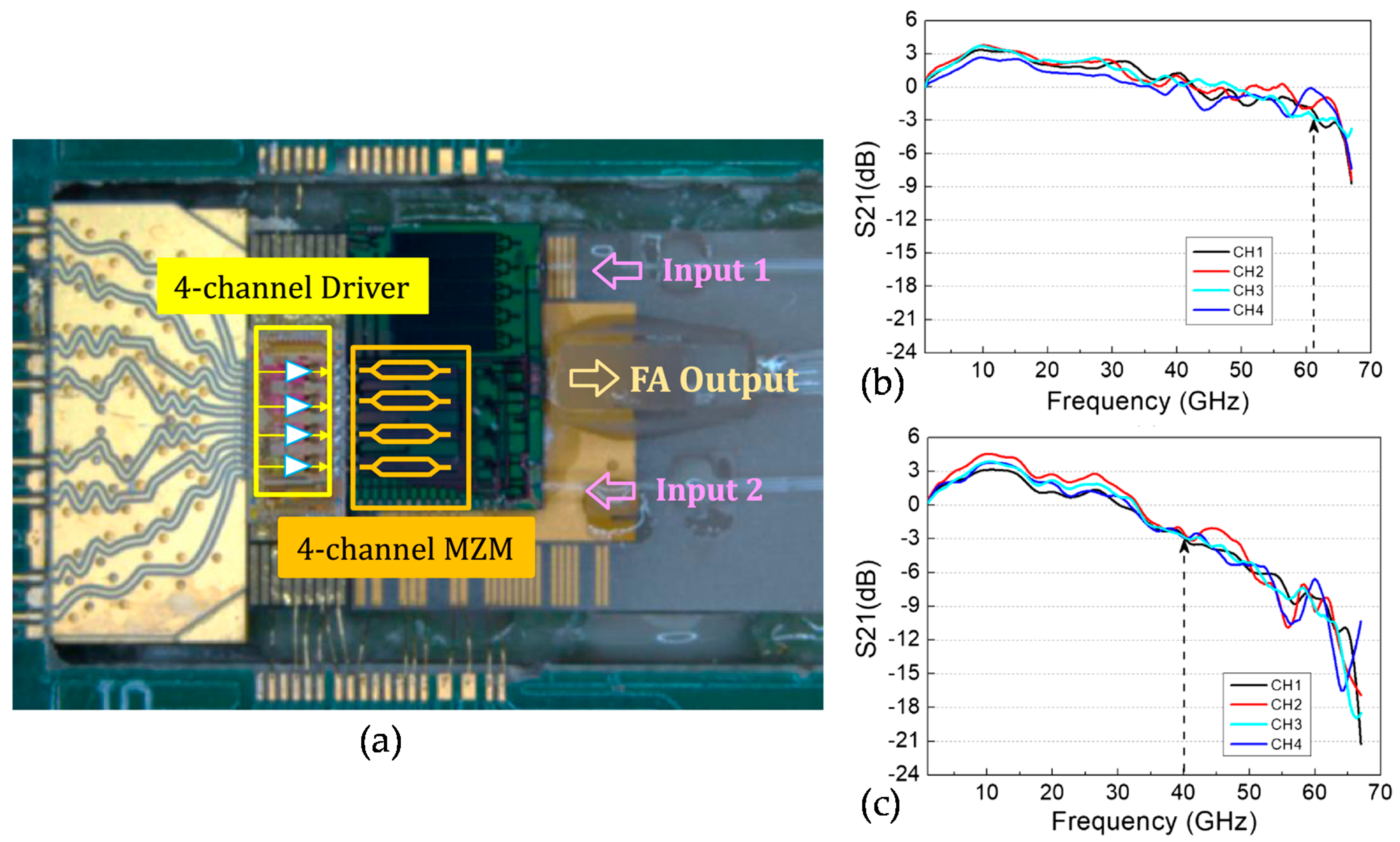


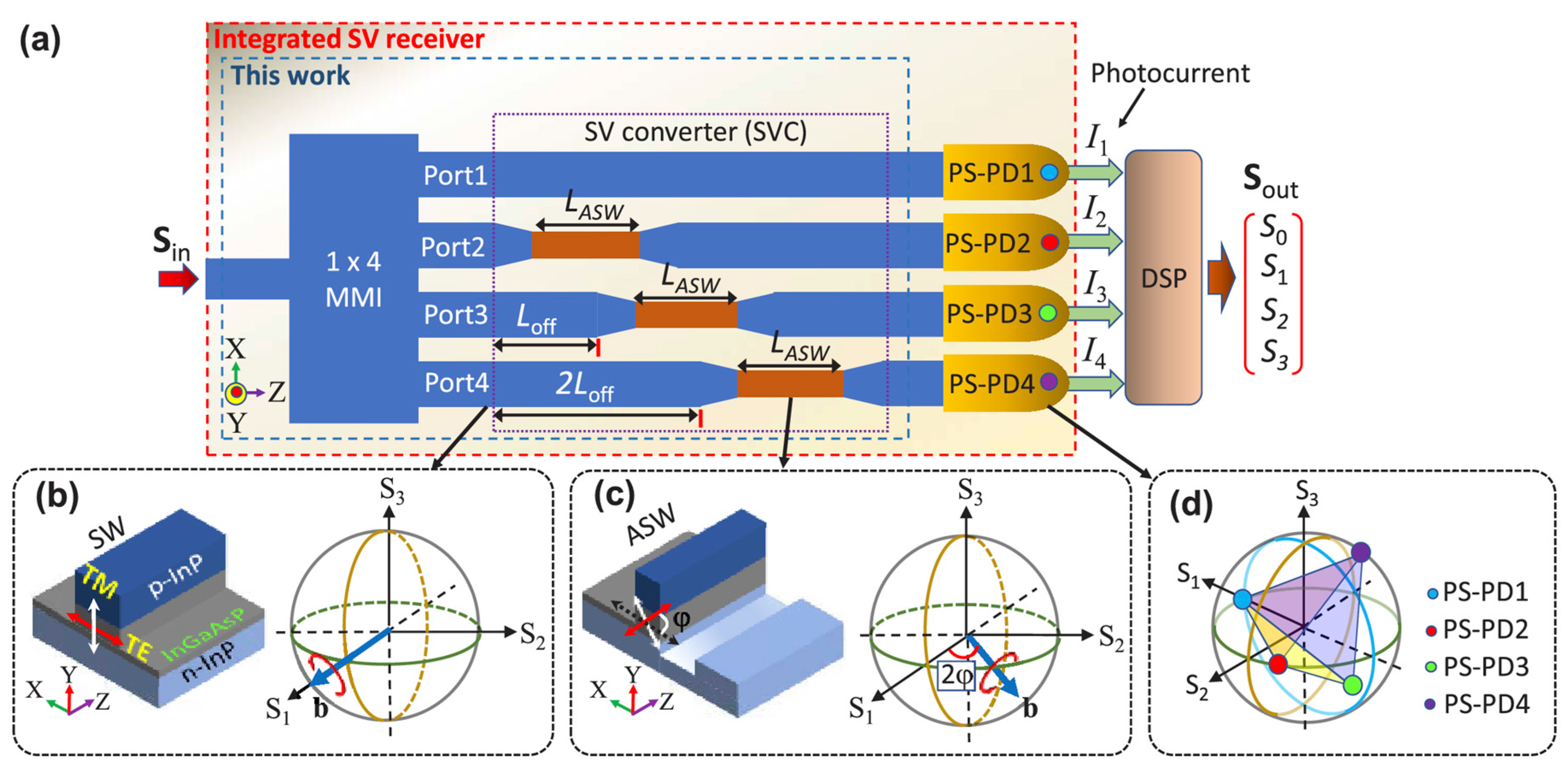

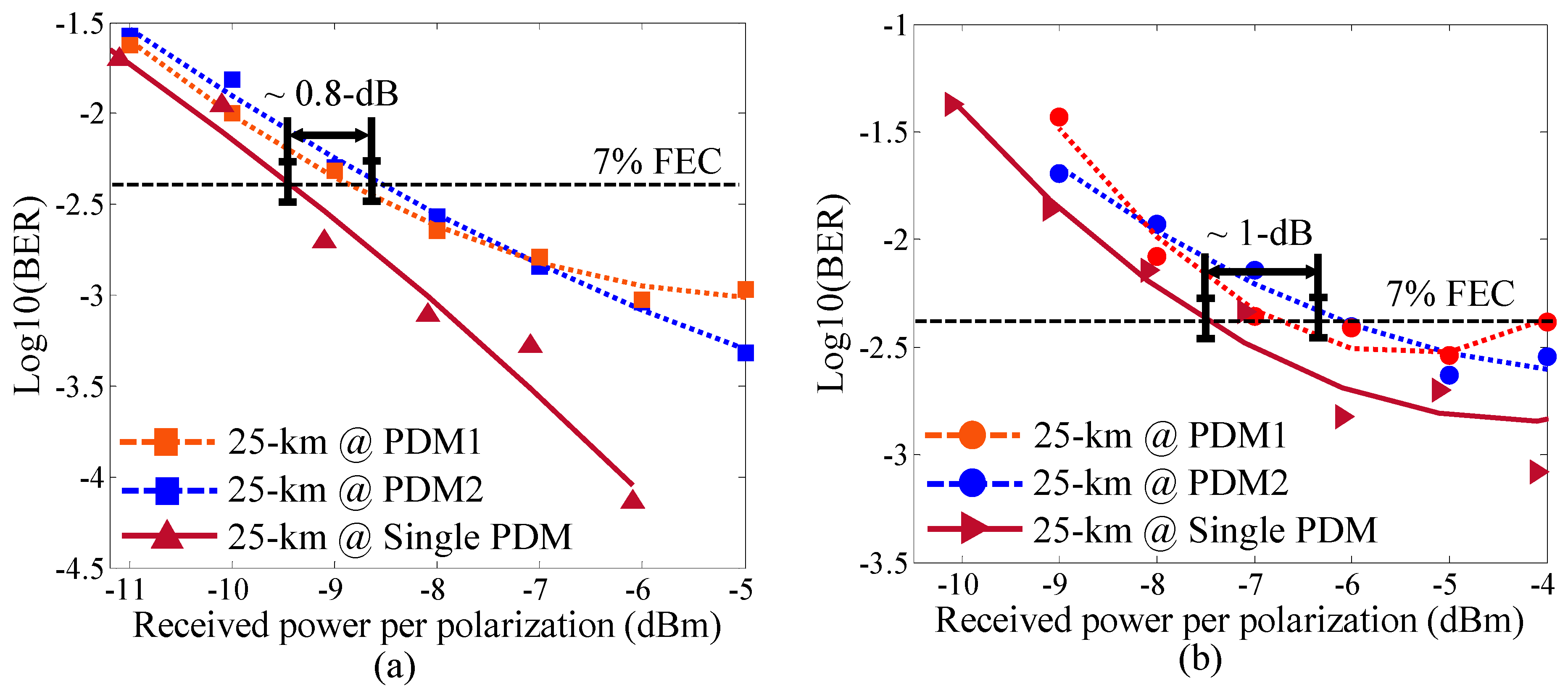
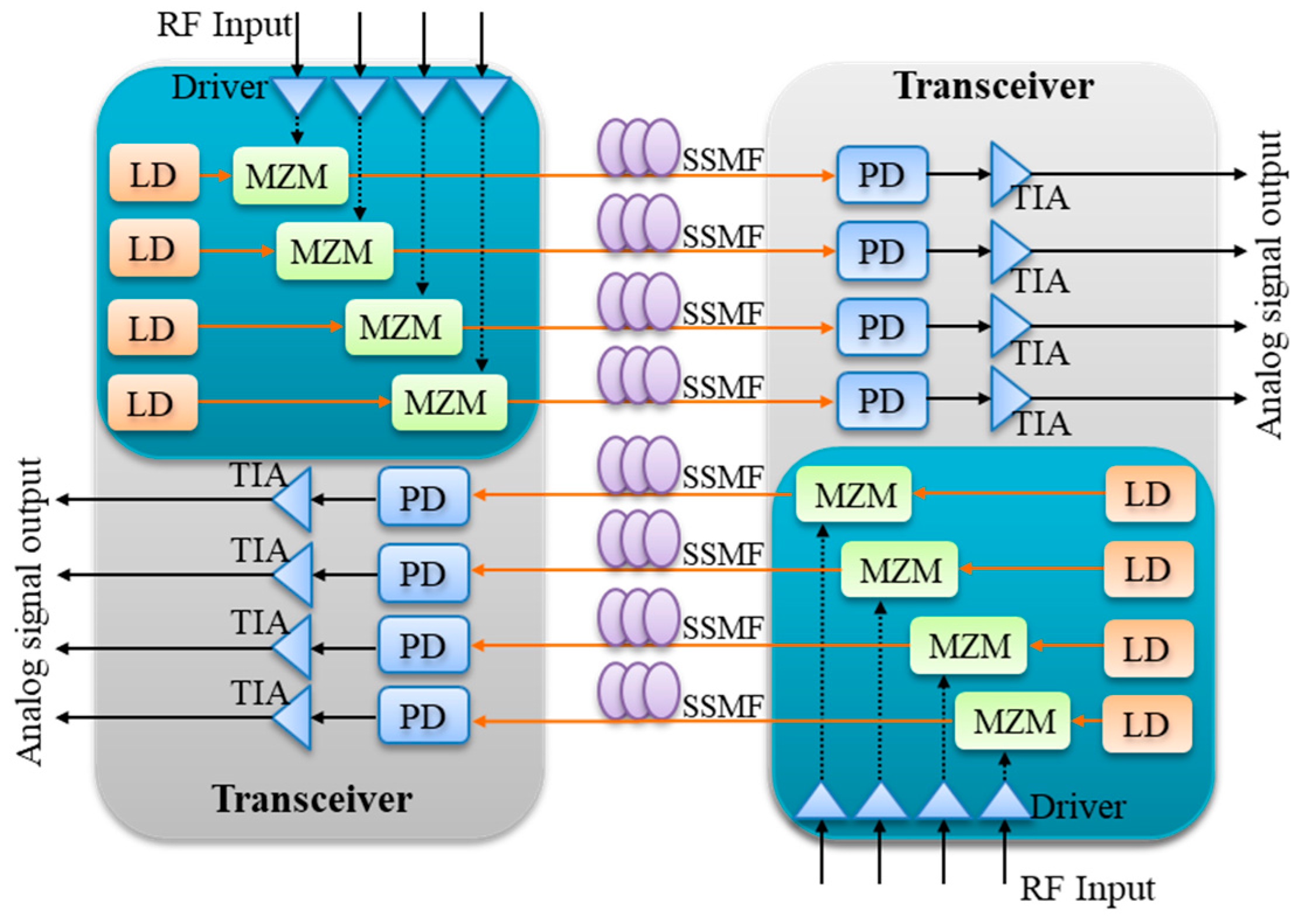

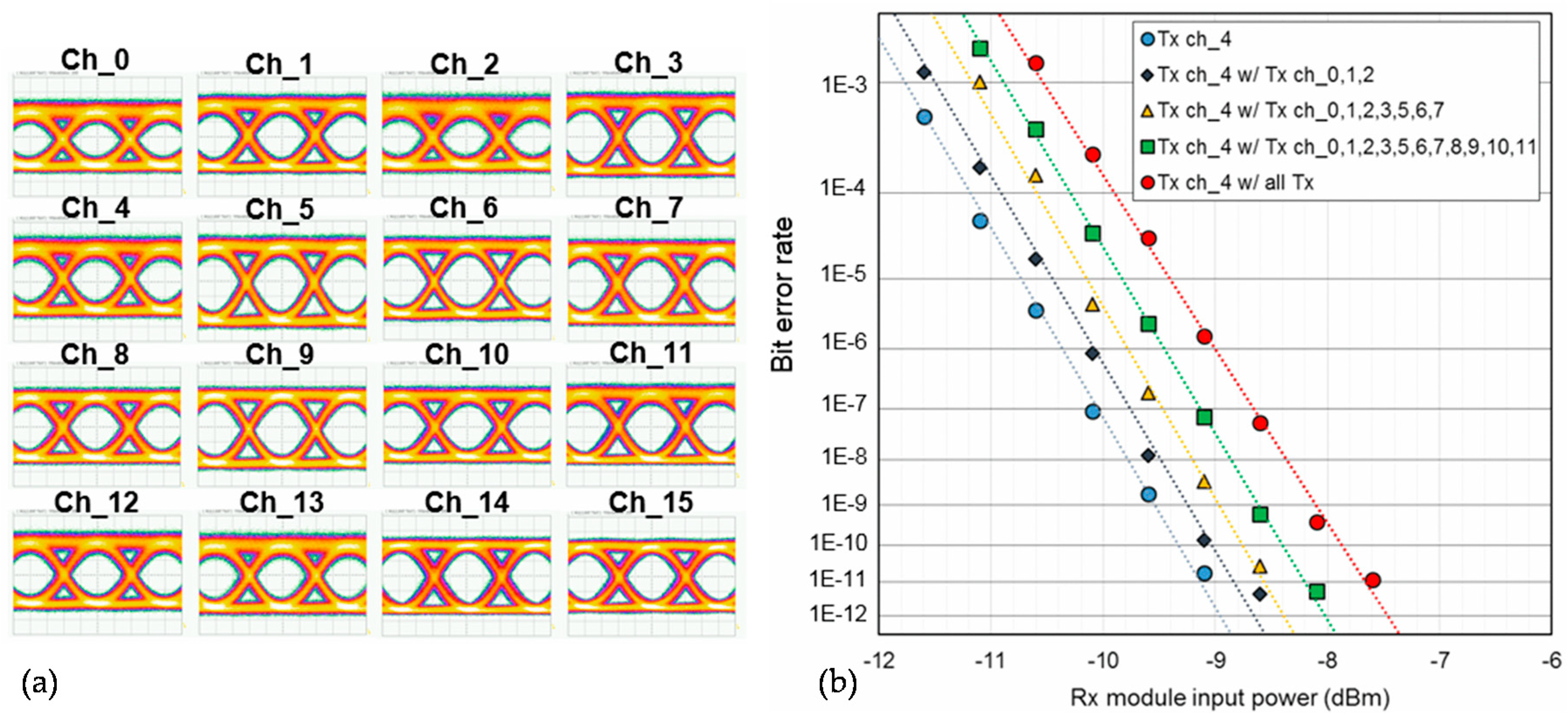
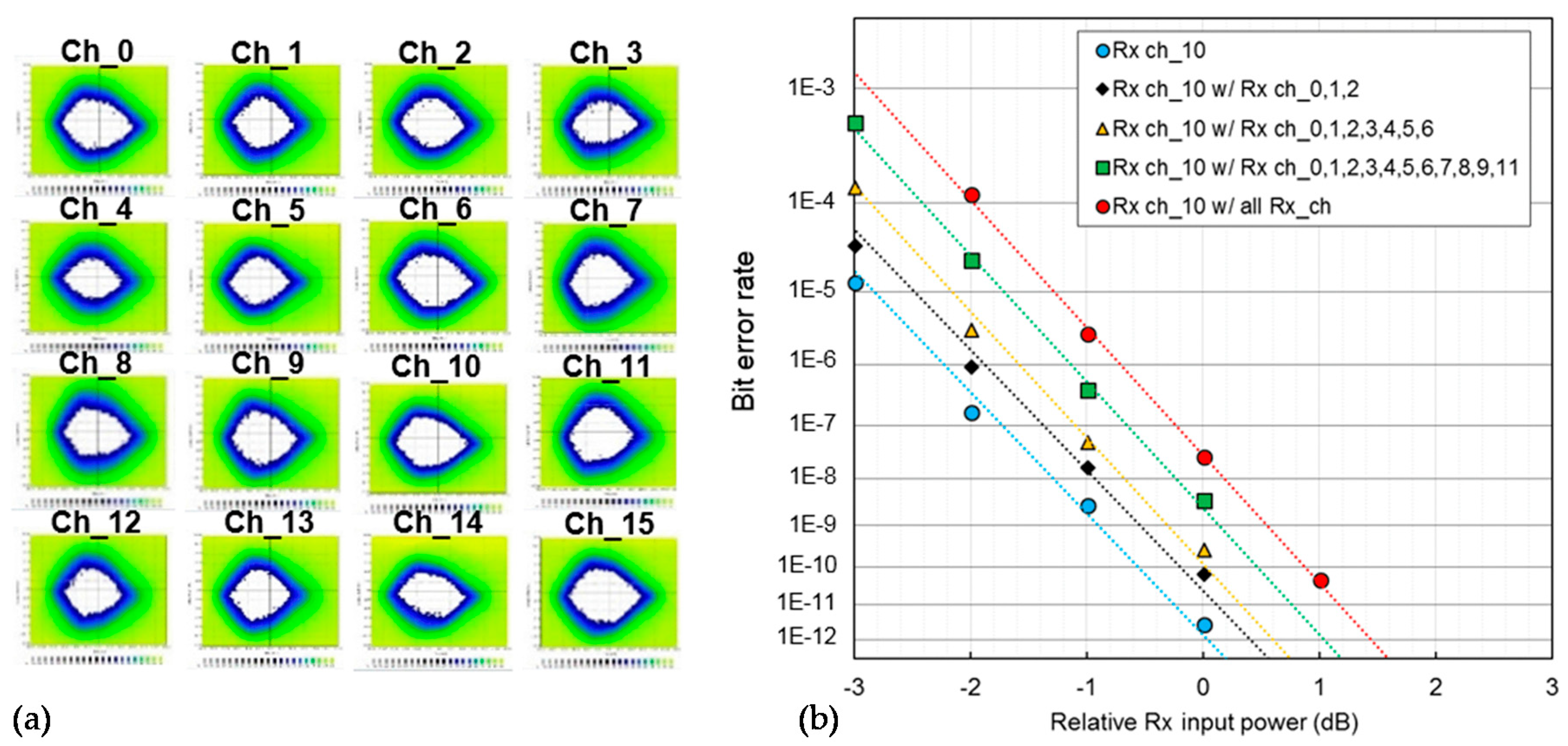
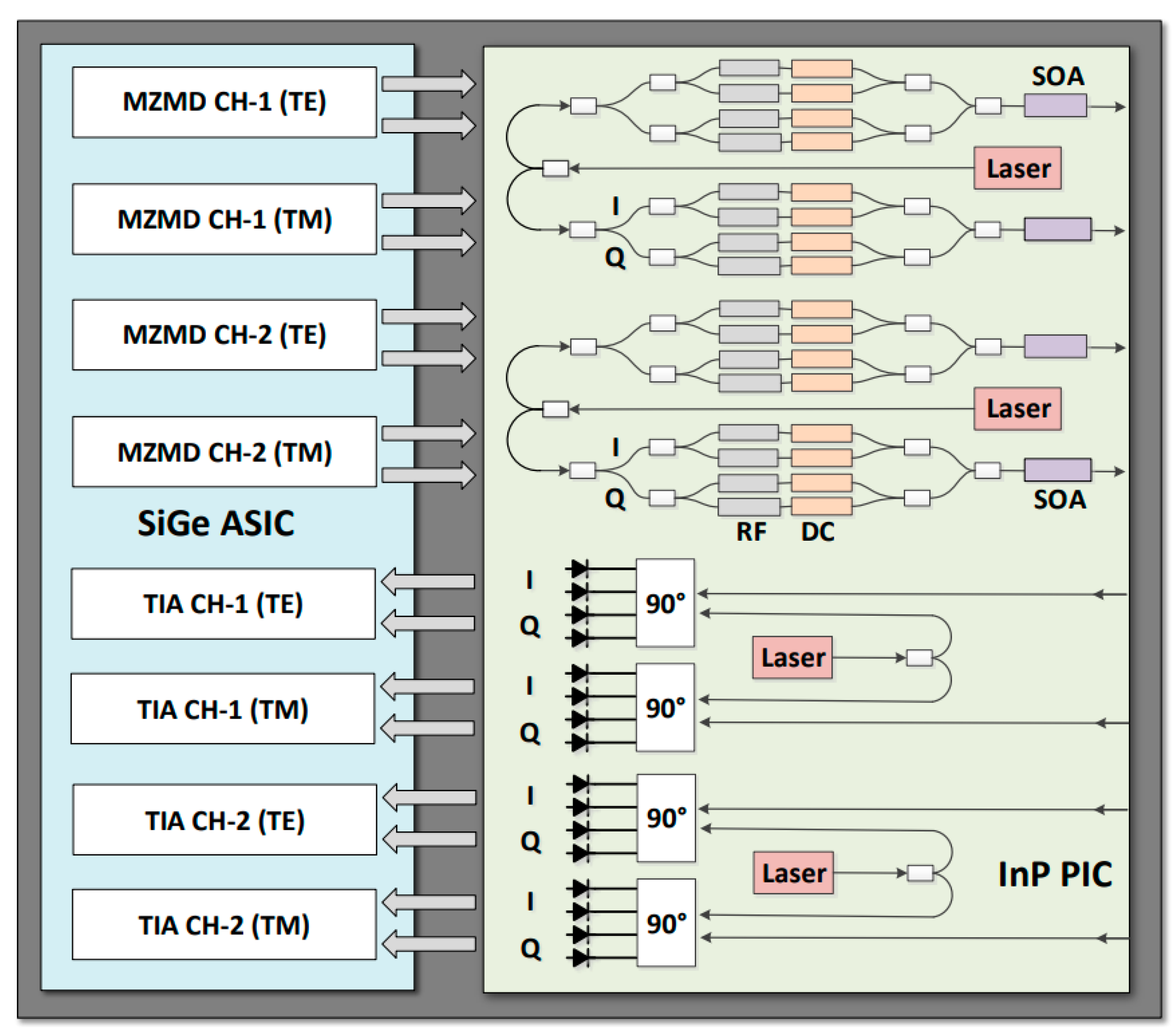
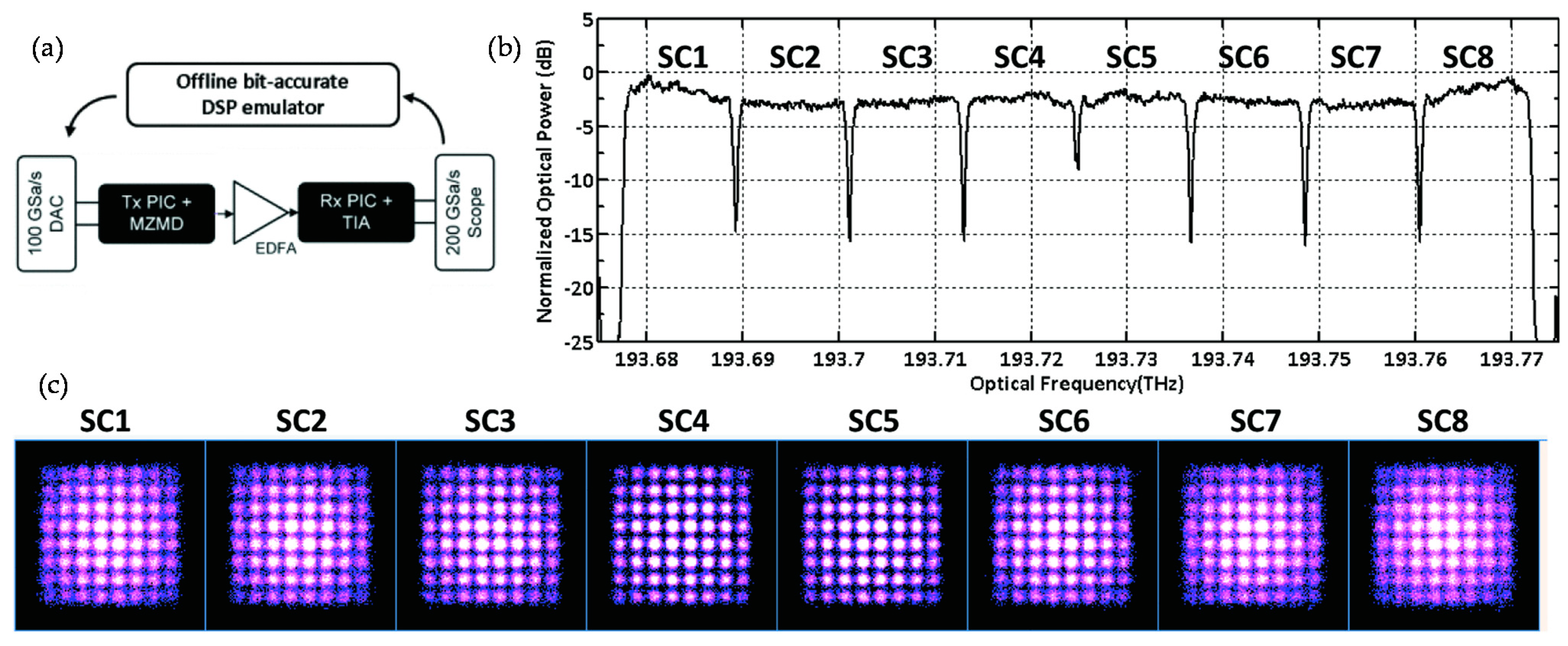
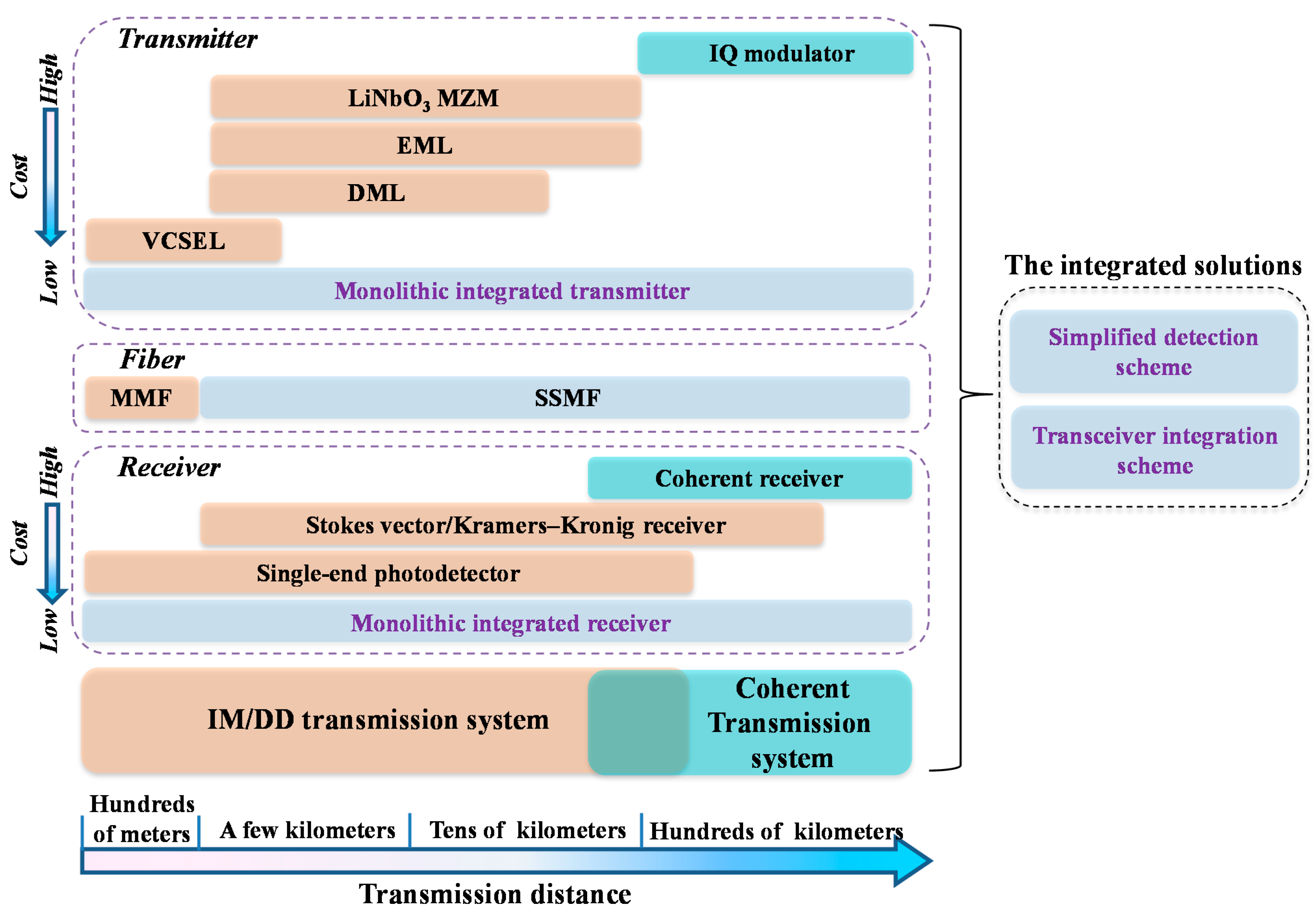
| Tx Device | λ (nm) | MF | BW (GHz) | Rate (Gbit/s) | Reach (m) | Fiber Type | FEC Limit | Ref. |
|---|---|---|---|---|---|---|---|---|
| MM-VCSEL | 850 | MultiCAP | ~20 | 107.5 | 10 | OM4-MMF | 3.8 × 10−3 | [31] |
| MM-VCSEL | 850 | PAM-8 | -- | 108 | 25 | OM3-MMF | 3.8 × 10−3 | [32] |
| MM-VCSEL | 850 | MultiCAP | 25 | 112 | 150 | OM4-MMF | 3.8 × 10−3 | [33] |
| MM-VCSEL | 850 | PAM-4 | 22 | 112 | 200 | OM4-MMF | 2 × 10−4 | [34] |
| MM-VCSEL | 850 | PAM-4 | ~28 | 168 | 50 | OM5-MMF | >1 × 10−6 | [35] |
| MM-VCSEL | 850 | PAM-4 | 25 | 112 | 200 | OM4-MMF | 4.2 × 10−4 | [36] |
| MM-VCSEL | 850 | PAM-4 | 25 | 200 | 100 | OM4-MMF | 4 × 10−3 | [37] |
| MM-VCSEL | 850 | PAM-4 | 20 | 100 | 100 | OM3-MMF | 3.8 × 10−3 | [38] |
| SM-VCSEL | 850 | DMT | 26 | 161 | 10 | OM4-MMF | 2.7 × 10−2 | [39] |
| SM-VCSEL | 850 | DMT | 25 | 112 | 300 | OM4-MMF | 3.8 × 10−3 | [40] |
| SM-VCSEL | 1543 | PAM-4 | ~23 | 100 | 1000 | SMF | 3.8 × 10−3 | [41] |
| SM-VCSEL | 1543.2 | PAM-4 | 22 | 100 | 2500 | SMF | 3.8 × 10−3 | [42] |
| Tx Device | λ (nm) | MF | BW (GHz) | Rate (Gbit/s) | Reach (km) | Fiber Type | FEC Limit | Ref. |
|---|---|---|---|---|---|---|---|---|
| DML | 1310 | PAM-4 | 28 | 112 | 40 | SMF | 3.8 × 10−3 | [8] |
| DML | C-band | PAM-4 | 16 | 100 | 15 | SMF | 3.8 × 10−3 | [9] |
| DML | 1300 | PAM-4 | 55 | 112 | 2.2 | SMF | 2 × 10−4 | [46] |
| DML | 1310 | DMT | 18 | 117 | 40 | SMF | 1 × 10−3 | [49] |
| DML | 1308.45 | PAM-4 | 25 | 112 | 20 | SMF | 4.6 × 10−3 | [50] |
| DML | 1286 | PAM-4 | >100 | 256 | 2 | SMF | 3.8 × 10−3 | [47] |
| DML | 1295.48 | DMT | 104.5 | 321.24 | 2 | SMF | 3.8 × 10−3 | [51] |
| DML | 1315 | PAM-8 | 54 | 240 | 10 | SMF | 1.8 × 10−2 | [52] |
| DML | 1313 | DMT | 65 | 368.8 | 15 | SMF | 1.8 × 10−2 | [53] |
| Tx Device | λ (nm) | MF | BW (GHz) | Rate (Gbit/s) | Reach (km) | Fiber Type | FEC Limit | Ref. |
|---|---|---|---|---|---|---|---|---|
| MZM | 1550 | PAM-8 | 30 | 120 | 10 | SMF | 1 × 10−2 | [56] |
| DDMZM | 1550 | DMT | 22 | 105 | 80 | SMF | 4.5 × 10−3 | [57] |
| MZM | 1545 | PAM-4 | 40 | 168 | 1 | SMF | 3.8 × 10−3 | [58] |
| MZM | 1550 | PAM-4 | 33 | 168 | 2 | SMF | 3.8 × 10−3 | [59] |
| DDMZM | ~1555 | PAM-4 | 30 | 128 | 80 | SMF | 2.4 × 10−2 | [60] |
| MZM | 1304.6 | PAM-8 | 30 | 255 | 10 | SMF | 2.5 × 10−4 | [61] |
| MZM | 1550 | PAM-4 | 40 | 200 | 40 | SMF + DCF | 3 × 10−4 | [62] |
| MZM | C-band | DMT | 30 | 244 | 1 | SMF | 4.5 × 10−3 | [63] |
| DDMZM | O-band | PAM-8 | 30 | 240 | 2 | MCF | 3.8 × 10−3 | [65] |
| MZM | 1293 | PAM-6 | 28 | 225 | 2 | SMF | 3.8 × 10−3 | [66] |
| MZM | 1310.96 | PS-PAM-8 | 60 | 280 | 10 | SMF | 3.8 × 10−3 | [67] |
| Tx Device | λ (nm) | MF | BW (GHz) | Rate (Gbit/s) | Reach (km) | Fiber Type | FEC Limit | Ref. |
|---|---|---|---|---|---|---|---|---|
| EML | 1298.5 | PAM-4 | 18 | 100 | 80 | SMF | 3.8 × 10−3 | [68] |
| AXEL | ~1307 | PAM-4 | 35 | 106 | 60 | SMF | 2 × 10−4 | [69] |
| EML | 1294.72 | PAM-4 | 20 | 112 | 40 | SMF | 3.8 × 10−3 | [70] |
| EML | 1293 | PAM-4 | 25 | 112 | 40 | SMF | 3.5 × 10−6 | [71] |
| EML | 1304 | PAM-4 | 17 | 112 | 40 | SMF | 3.8 × 10−3 | [72] |
| DS-EML | 1538.74 | PAM-8 | 40 | 129 | 5 | SMF | 3.8 × 10−3 | [73] |
| EML | 1310 | PAM-4 | 35 | 214 | 10 | SMF | 2 × 10−4 | [74] |
| EML | 1550 | PS-PAM-8 | 40 | 260 | 1 | NZDSF | 2 × 10−2 | [75] |
| DFB-TWEAM | 1550 | OOK | >100 | 204 | 10 | SMF + DCF | 1.1 × 10−2 | [76] |
| DFB-TWEAM | 1550 | PAM-4 | >100 | 200 | 0.4 | SMF | 2 × 10−2 | [77] |
| DFB-TWEAM | 1550 | DMT | >100 | 200 | 1.6 | SMF | 2.7 × 10−2 | [78] |
| Tx Device | λ (nm) | MF | BW (GHz) | Rate (Gbit/s) | Reach (km) | Fiber Type | FEC Limit | Ref. |
|---|---|---|---|---|---|---|---|---|
| InP-Based DFB-MZM | 1542 | PAM-8 | 54 | 300 | 1.2 | SMF | 1.9 × 10−2 | [15] |
| InP-Based MZM | 1550 | DMT | 80 | 333 | 20 | SMF + DCF | 2.7 × 10−2 | [16] |
| SiP-based MZM | 1550 | PAM-4 | >50 | 128 | 10 | SMF + DCF | 2 × 10−2 | [79] |
| SiP-based MZM | 1310 | PAM-8 | 20 | 112 | 10 | SMF | 3.8 × 10−3 | [80] |
| SiP-based DDTW-MZM | 1546.98 | PAM-4 | 22.5 | 176 | 1 | SMF | 1.5 × 10−2 | [81] |
| SiP-based DDTW-MZM | 1546.98 | PAM-6 | 22.5 | 200 | 1 | SMF | 1.5 × 10−2 | [82] |
| SiP-based DDTW-MZM | 1546.98 | SSB- PAM-4 | 22.5 | 176 | 400 | SMF | 4 × 10−2 | [83] |
| SiP-based DDTW-MZM | 1546.98 | PAM-4 | 22.5 | 184 | 320 | SMF | 2.4 × 10−2 | [84] |
| SiP-based ME-MZM | O-band | PAM-4 | >35 | 112 | 10 | SMF | 2.4 × 10−2 | [85] |
| SiP-based TW-MZM | O-band | PAM-8 | 47 | 255 | 2 | SMF | 3.8 × 10−3 | [86] |
| SiP-based POH-MZM | 1541.9 | OOK | >70 | 222 | 0.12 | SMF | 2.24 × 10−2 | [87] |
| SiP-based 4ch-MZM | ~1540 | PAM-4 | 40 | 200 | 1 | SMF | 3.8 × 10−3 | [88] |
| SiP-based MRM | 1541.57 | PAM-4 | 47 | 160 | 1 | SMF | 2.12 × 10−3 | [89] |
| Tx | λ | Fiber | Reach | BW | Chirp | Footprint | Cost |
|---|---|---|---|---|---|---|---|
| IQ Modulator | O-/C-Band | SMF | >80 km | high | -- | high | high |
| MZM | O-/C-Band | SMF | <80 km | high | -- | high | high |
| EML | O-/C-Band | SMF | <80 km | high | low | moderate | moderate |
| DML | Mostly O-Band Partially C-Band | SMF | <40 km | moderate | high | low | low |
| VCSEL | Mostly 850 nm Partially C-Band | MMF/SMF | <300 m <2 km | low | high | low | Very low |
| Monolithic integrated transmitter | O-/C-Band | SMF | whole range | high | -- | low | moderate |
| Rx | Reach | Footprint | Sensitivity | Cost |
|---|---|---|---|---|
| Coherent receiver | high | high | high | high |
| Stokes vector receiver | moderate | moderate | moderate | moderate |
| Kramers-Kronig receiver | moderate | moderate | moderate | moderate |
| Single-end PD | low | low | low | low |
| Monolithic integrated receiver | whole range | low | whole range | Very low |
Publisher’s Note: MDPI stays neutral with regard to jurisdictional claims in published maps and institutional affiliations. |
© 2021 by the authors. Licensee MDPI, Basel, Switzerland. This article is an open access article distributed under the terms and conditions of the Creative Commons Attribution (CC BY) license (http://creativecommons.org/licenses/by/4.0/).
Share and Cite
Jiang, L.; Yan, L.; Yi, A.; Pan, Y.; Zhang, B.; Hu, Q.; Pan, W.; Luo, B. Integrated Components and Solutions for High-Speed Short-Reach Data Transmission. Photonics 2021, 8, 77. https://doi.org/10.3390/photonics8030077
Jiang L, Yan L, Yi A, Pan Y, Zhang B, Hu Q, Pan W, Luo B. Integrated Components and Solutions for High-Speed Short-Reach Data Transmission. Photonics. 2021; 8(3):77. https://doi.org/10.3390/photonics8030077
Chicago/Turabian StyleJiang, Lin, Lianshan Yan, Anlin Yi, Yan Pan, Bo Zhang, Qianggao Hu, Wei Pan, and Bin Luo. 2021. "Integrated Components and Solutions for High-Speed Short-Reach Data Transmission" Photonics 8, no. 3: 77. https://doi.org/10.3390/photonics8030077
APA StyleJiang, L., Yan, L., Yi, A., Pan, Y., Zhang, B., Hu, Q., Pan, W., & Luo, B. (2021). Integrated Components and Solutions for High-Speed Short-Reach Data Transmission. Photonics, 8(3), 77. https://doi.org/10.3390/photonics8030077






